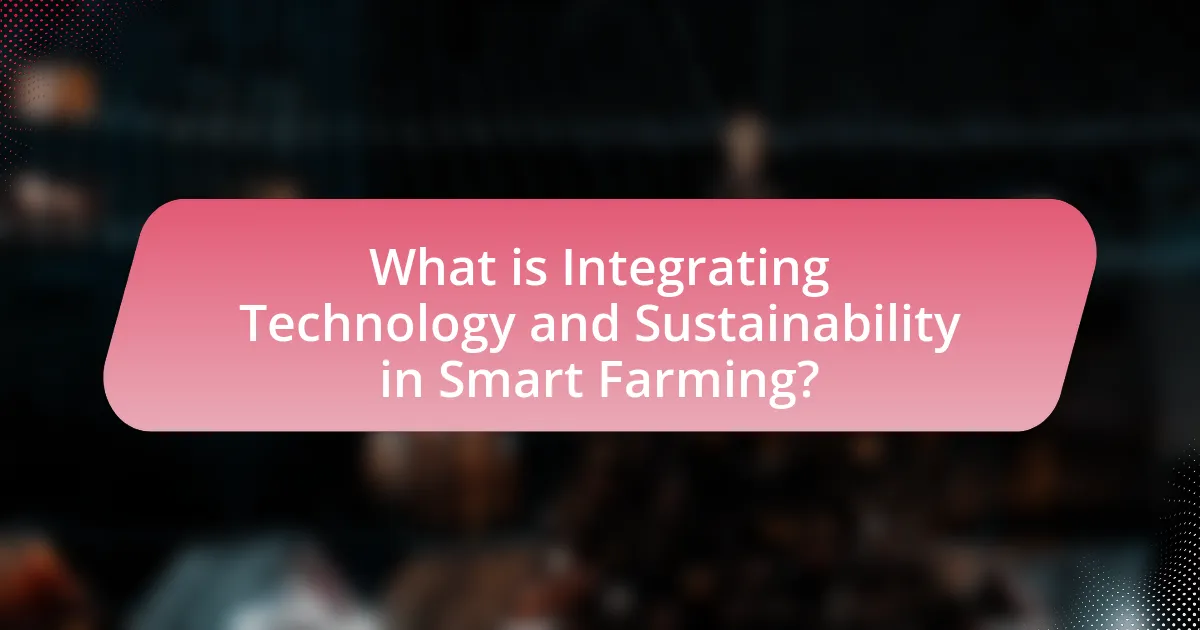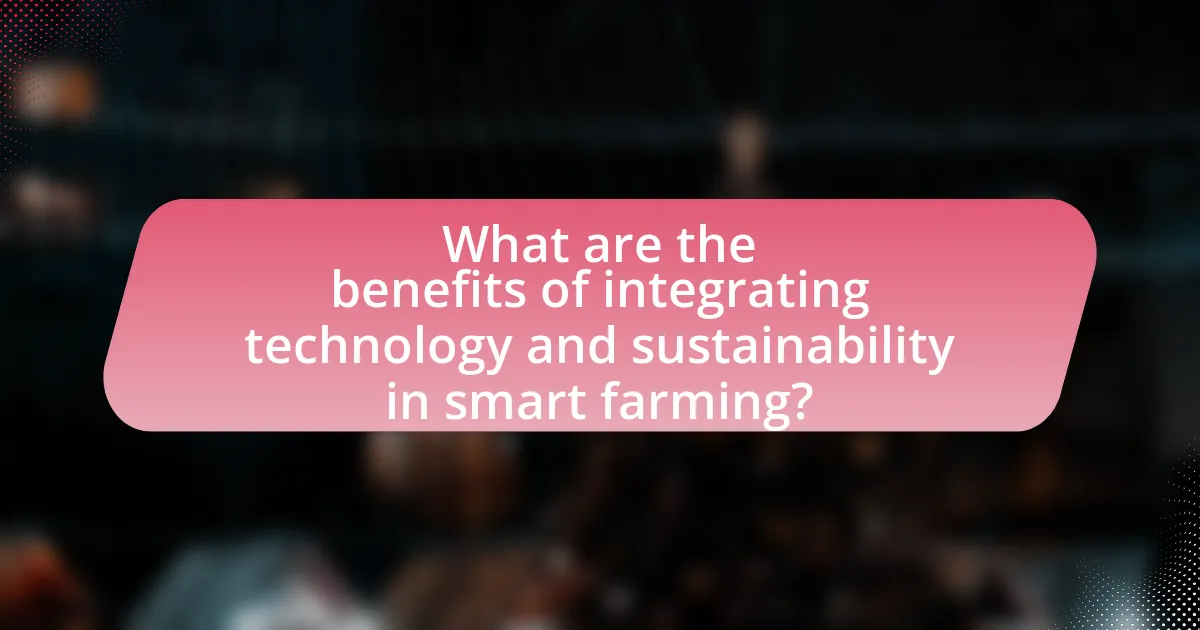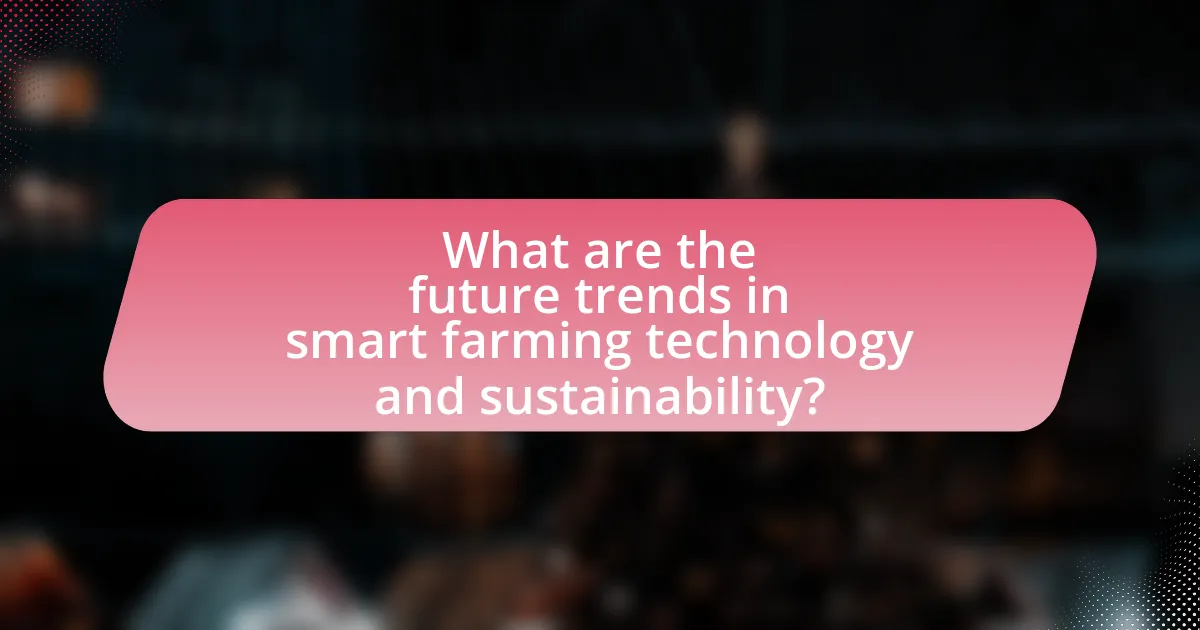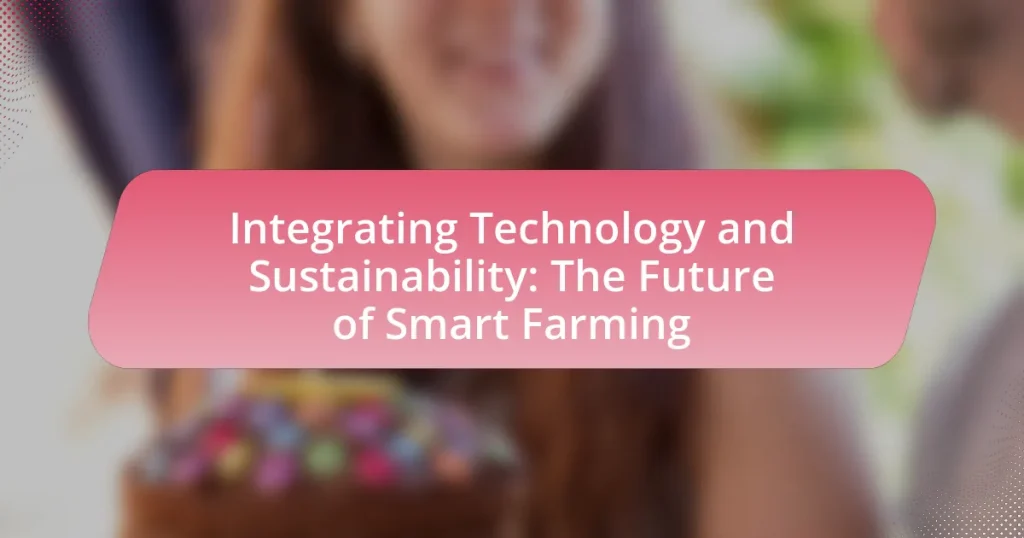Integrating technology and sustainability in smart farming involves the use of advanced technologies such as IoT, AI, and data analytics to enhance agricultural practices while minimizing environmental impact. This article explores how these technologies optimize resource use, improve crop yields, and reduce waste through precision agriculture techniques. It discusses specific technologies employed in smart farming, their contributions to sustainable practices, and the economic advantages they offer to farmers. Additionally, the article addresses the challenges traditional farming faces and highlights the importance of transitioning to smart farming for long-term agricultural viability and environmental conservation.

What is Integrating Technology and Sustainability in Smart Farming?
Integrating technology and sustainability in smart farming refers to the application of advanced technologies, such as IoT, AI, and data analytics, to enhance agricultural practices while minimizing environmental impact. This integration allows farmers to optimize resource use, improve crop yields, and reduce waste through precision agriculture techniques. For instance, a study by the Food and Agriculture Organization (FAO) highlights that smart farming technologies can lead to a 20-30% increase in productivity while decreasing water usage by up to 50%. This demonstrates that the combination of technology and sustainable practices is essential for achieving efficient and environmentally friendly agricultural systems.
How does technology enhance sustainability in smart farming?
Technology enhances sustainability in smart farming by optimizing resource use, reducing waste, and increasing crop yields. Precision agriculture technologies, such as GPS-guided equipment and soil sensors, enable farmers to apply water, fertilizers, and pesticides more efficiently, minimizing environmental impact. For instance, a study by the Food and Agriculture Organization indicates that precision farming can reduce water usage by up to 30% while maintaining productivity. Additionally, data analytics and IoT devices allow for real-time monitoring of crop health and soil conditions, leading to informed decision-making that supports sustainable practices. These advancements collectively contribute to a more sustainable agricultural system by promoting efficient resource management and reducing the carbon footprint associated with farming activities.
What specific technologies are used in smart farming?
Smart farming utilizes specific technologies such as IoT (Internet of Things), drones, precision agriculture tools, and big data analytics. IoT devices enable real-time monitoring of soil conditions, crop health, and weather patterns, enhancing decision-making. Drones are employed for aerial imaging and crop surveillance, allowing farmers to assess field conditions efficiently. Precision agriculture tools, including GPS-guided equipment, optimize planting and harvesting processes, reducing waste and increasing yield. Big data analytics processes vast amounts of agricultural data to identify trends and improve farming practices. These technologies collectively enhance productivity and sustainability in agriculture.
How do these technologies contribute to sustainable practices?
Technologies in smart farming contribute to sustainable practices by optimizing resource use and minimizing environmental impact. For instance, precision agriculture employs data analytics and IoT sensors to monitor soil health, water usage, and crop conditions, leading to reduced fertilizer and pesticide application. According to a study by the Food and Agriculture Organization, precision farming can decrease chemical inputs by up to 30%, which not only lowers costs for farmers but also mitigates soil and water pollution. Additionally, technologies such as automated irrigation systems conserve water by delivering it directly to plant roots, resulting in water savings of 20-50% compared to traditional methods. These advancements collectively enhance agricultural productivity while promoting ecological balance.
Why is the integration of technology and sustainability important for agriculture?
The integration of technology and sustainability is crucial for agriculture because it enhances productivity while minimizing environmental impact. Advanced technologies such as precision farming, which utilizes data analytics and IoT devices, enable farmers to optimize resource use, reducing water and fertilizer consumption by up to 30% according to the Food and Agriculture Organization. This integration not only increases crop yields but also promotes sustainable practices that protect ecosystems and biodiversity, ensuring long-term agricultural viability.
What challenges does traditional farming face that technology can address?
Traditional farming faces challenges such as inefficient resource management, pest control, and crop yield optimization, which technology can effectively address. For instance, precision agriculture technologies utilize data analytics and IoT devices to optimize water usage, reducing waste by up to 30% according to the USDA. Additionally, drones and satellite imagery can monitor crop health and detect pest infestations early, leading to timely interventions that can increase yields by 10-20%. Furthermore, automation in planting and harvesting can significantly reduce labor costs and improve efficiency, as evidenced by the adoption of robotic systems in various agricultural sectors.
How does sustainable farming impact the environment and society?
Sustainable farming positively impacts the environment and society by promoting biodiversity, reducing pollution, and enhancing food security. This agricultural approach utilizes practices such as crop rotation, organic fertilizers, and integrated pest management, which contribute to healthier ecosystems. For instance, a study published in the journal “Nature Sustainability” found that sustainable farming methods can increase biodiversity by up to 30% compared to conventional practices. Additionally, sustainable farming reduces reliance on chemical inputs, leading to lower levels of water and soil contamination, which benefits both human health and wildlife. Furthermore, it supports local economies by creating jobs and fostering community resilience, as seen in various cooperative farming initiatives that empower local farmers and improve access to fresh produce.
What are the key principles of smart farming?
The key principles of smart farming include precision agriculture, data-driven decision-making, automation, and sustainability. Precision agriculture utilizes technology such as GPS and IoT sensors to monitor and manage field variability in crops, optimizing inputs like water and fertilizers. Data-driven decision-making involves analyzing data collected from various sources to enhance productivity and efficiency, with studies showing that data analytics can increase crop yields by up to 20%. Automation encompasses the use of robotics and drones to perform tasks such as planting, harvesting, and monitoring, which can reduce labor costs and improve operational efficiency. Lastly, sustainability focuses on practices that minimize environmental impact, such as reducing chemical usage and conserving water, aligning with global goals for sustainable development in agriculture.
How do precision agriculture techniques improve resource management?
Precision agriculture techniques improve resource management by utilizing data-driven insights to optimize inputs such as water, fertilizers, and pesticides. These techniques, including GPS-guided equipment and remote sensing, enable farmers to apply resources more efficiently, reducing waste and enhancing crop yields. For instance, a study by the USDA found that precision irrigation can reduce water usage by up to 30% while maintaining crop productivity. This targeted approach not only conserves resources but also minimizes environmental impact, demonstrating the effectiveness of precision agriculture in sustainable farming practices.
What role does data analytics play in smart farming?
Data analytics plays a crucial role in smart farming by enabling farmers to make data-driven decisions that enhance productivity and sustainability. Through the collection and analysis of data from various sources such as soil sensors, weather stations, and crop monitoring systems, farmers can optimize resource use, improve crop yields, and reduce environmental impact. For instance, a study published in the journal “Precision Agriculture” found that data analytics can lead to a 10-20% increase in crop yields by providing insights into optimal planting times and resource allocation. This demonstrates that data analytics is essential for maximizing efficiency and sustainability in modern agricultural practices.
How can farmers transition to smart farming practices?
Farmers can transition to smart farming practices by adopting precision agriculture technologies, such as sensors, drones, and data analytics. These technologies enable farmers to monitor crop health, optimize resource use, and improve yields. For instance, a study by the Food and Agriculture Organization (FAO) indicates that precision agriculture can increase crop productivity by up to 20% while reducing input costs by 10-15%. Additionally, farmers should invest in training programs to enhance their technical skills and collaborate with technology providers to implement these innovations effectively.
What are the barriers to adopting technology in sustainable farming?
The barriers to adopting technology in sustainable farming include high initial costs, lack of technical knowledge, and limited access to reliable internet. High initial costs deter farmers from investing in advanced technologies, as many sustainable farming practices require significant upfront capital. Additionally, a lack of technical knowledge among farmers can hinder the effective implementation and use of these technologies, leading to underutilization. Limited access to reliable internet, particularly in rural areas, restricts the ability to utilize data-driven tools and platforms essential for modern sustainable farming practices. These factors collectively impede the widespread adoption of technology in the sector.

What are the benefits of integrating technology and sustainability in smart farming?
Integrating technology and sustainability in smart farming enhances productivity, reduces environmental impact, and promotes resource efficiency. Smart farming technologies, such as precision agriculture, utilize data analytics and IoT devices to optimize crop yields while minimizing inputs like water and fertilizers. For instance, a study by the Food and Agriculture Organization (FAO) indicates that precision agriculture can increase crop productivity by up to 20% while reducing water usage by 30%. Additionally, sustainable practices, such as crop rotation and organic farming, when combined with technology, lead to healthier soil and biodiversity, further supporting long-term agricultural viability.
How does smart farming improve crop yields?
Smart farming improves crop yields by utilizing advanced technologies such as precision agriculture, data analytics, and IoT devices to optimize farming practices. These technologies enable farmers to monitor soil conditions, weather patterns, and crop health in real-time, allowing for more informed decision-making. For instance, a study by the Food and Agriculture Organization (FAO) indicates that precision agriculture can increase crop yields by 10-30% through targeted resource application and reduced waste. Additionally, smart farming techniques, such as automated irrigation systems, ensure that crops receive the right amount of water at the right time, further enhancing productivity.
What technologies specifically enhance crop production?
Technologies that specifically enhance crop production include precision agriculture, biotechnology, and automated farming equipment. Precision agriculture utilizes GPS and IoT sensors to optimize field-level management regarding crop farming, leading to increased yields and reduced resource waste. Biotechnology involves genetic modification and tissue culture techniques that improve crop resilience and productivity; for instance, genetically modified crops can withstand pests and adverse weather conditions, resulting in higher outputs. Automated farming equipment, such as drones and robotic harvesters, streamlines planting, monitoring, and harvesting processes, significantly increasing efficiency and reducing labor costs. These technologies collectively contribute to sustainable farming practices by maximizing productivity while minimizing environmental impact.
How does improved yield contribute to food security?
Improved yield directly enhances food security by increasing the availability of food resources to meet the demands of a growing population. Higher agricultural productivity ensures that more food is produced per unit of land, which is crucial as global population projections indicate an increase to approximately 9.7 billion by 2050. According to the Food and Agriculture Organization (FAO), achieving a 70% increase in food production is necessary to feed this population. Enhanced yields can be achieved through advanced agricultural practices, such as precision farming and genetically modified organisms (GMOs), which optimize resource use and reduce losses. These methods not only boost the quantity of food produced but also improve its nutritional quality, further contributing to overall food security.
What economic advantages does smart farming offer to farmers?
Smart farming offers significant economic advantages to farmers, primarily through increased efficiency and reduced costs. By utilizing precision agriculture technologies, farmers can optimize resource use, such as water and fertilizers, leading to lower input costs. For instance, a study by the International Food Policy Research Institute found that precision farming can reduce fertilizer use by up to 30%, directly impacting the farmer’s bottom line. Additionally, smart farming technologies enable better crop monitoring and yield prediction, which can enhance decision-making and increase overall productivity. According to a report from McKinsey & Company, implementing smart farming practices can potentially increase farm profits by 20% to 30% over time.
How can technology reduce operational costs?
Technology can reduce operational costs by automating processes, optimizing resource use, and enhancing data management. Automation through robotics and AI minimizes labor costs and increases efficiency, as seen in smart farming where tasks like planting and harvesting are performed with precision. Additionally, technologies such as IoT sensors enable real-time monitoring of soil and crop conditions, allowing farmers to apply water and fertilizers more efficiently, which can lead to a reduction in input costs by up to 30%. Furthermore, data analytics tools help in making informed decisions that can streamline operations and reduce waste, contributing to overall cost savings.
What financial incentives exist for adopting sustainable practices?
Financial incentives for adopting sustainable practices include tax credits, grants, and subsidies aimed at reducing the costs associated with implementing eco-friendly technologies. For instance, the U.S. government offers the Investment Tax Credit (ITC) for solar energy systems, allowing businesses to deduct a significant percentage of installation costs from their federal taxes. Additionally, various state and local programs provide grants to farmers who implement sustainable practices, such as precision agriculture techniques, which can lead to increased efficiency and reduced input costs. According to the USDA, sustainable farming practices can also enhance crop yields and improve soil health, leading to long-term financial benefits.
How does smart farming contribute to environmental conservation?
Smart farming contributes to environmental conservation by optimizing resource use and reducing waste. Through precision agriculture techniques, such as soil moisture sensors and GPS-guided equipment, farmers can apply water, fertilizers, and pesticides more efficiently, minimizing runoff and pollution. For instance, a study published in the journal “Agricultural Systems” found that precision farming can reduce nitrogen fertilizer use by up to 30%, significantly lowering the risk of waterway contamination. Additionally, smart farming practices enhance biodiversity by promoting crop rotation and integrated pest management, which help maintain healthy ecosystems.
What impact does reduced chemical usage have on ecosystems?
Reduced chemical usage positively impacts ecosystems by enhancing biodiversity and improving soil health. When chemicals such as pesticides and fertilizers are minimized, non-target species, including beneficial insects and microorganisms, thrive, leading to a more balanced ecosystem. Research indicates that organic farming practices, which typically involve reduced chemical inputs, can increase species richness by 30% compared to conventional methods (Bengtsson et al., 2005, “The role of organic farming in biodiversity conservation”). Additionally, healthier soil, enriched with organic matter, supports better water retention and nutrient cycling, further promoting ecosystem resilience.
How does smart farming promote biodiversity?
Smart farming promotes biodiversity by utilizing precision agriculture techniques that enhance ecosystem health and resilience. These techniques include the use of sensors and data analytics to optimize resource use, which reduces chemical inputs and minimizes habitat destruction. For instance, smart farming practices can lead to a 20% reduction in pesticide use, thereby protecting non-target species and promoting a more diverse range of flora and fauna. Additionally, smart farming encourages crop rotation and polyculture, which further supports biodiversity by creating varied habitats and reducing monoculture risks.

What are the future trends in smart farming technology and sustainability?
Future trends in smart farming technology and sustainability include the increased use of precision agriculture, automation, and data analytics. Precision agriculture utilizes GPS and IoT sensors to optimize field-level management regarding crop farming, which can lead to higher yields and reduced environmental impact. Automation, through robotics and drones, enhances efficiency in planting, monitoring, and harvesting crops, thereby minimizing labor costs and resource usage. Data analytics enables farmers to make informed decisions based on real-time data, improving resource allocation and sustainability practices. According to a report by MarketsandMarkets, the smart agriculture market is projected to grow from $13.7 billion in 2020 to $22 billion by 2025, indicating a significant shift towards technology-driven farming solutions that prioritize sustainability.
How is artificial intelligence shaping the future of smart farming?
Artificial intelligence is transforming smart farming by enhancing decision-making processes, optimizing resource use, and improving crop yields. AI technologies, such as machine learning and data analytics, enable farmers to analyze vast amounts of data from sensors and drones, leading to precise insights on soil health, weather patterns, and crop conditions. For instance, a study by the Food and Agriculture Organization (FAO) indicates that AI-driven precision agriculture can increase crop productivity by up to 30% while reducing water usage by 20%. This integration of AI not only boosts efficiency but also promotes sustainable farming practices, aligning with global efforts to address food security and environmental challenges.
What are the potential applications of AI in agriculture?
AI has several potential applications in agriculture, including precision farming, crop monitoring, pest detection, and yield prediction. Precision farming utilizes AI algorithms to analyze data from various sources, enabling farmers to optimize resource use and improve crop yields. Crop monitoring systems employ AI-driven drones and sensors to assess plant health and soil conditions in real-time, allowing for timely interventions. Pest detection technologies leverage machine learning to identify and classify pests, reducing the need for chemical pesticides. Yield prediction models use historical data and environmental factors to forecast crop production, aiding in better planning and resource allocation. These applications demonstrate how AI can enhance efficiency and sustainability in agricultural practices.
How can AI improve decision-making for farmers?
AI can improve decision-making for farmers by providing data-driven insights that enhance crop management and resource allocation. Through the use of machine learning algorithms, AI analyzes vast amounts of data from various sources, such as weather patterns, soil conditions, and crop health, enabling farmers to make informed decisions about planting, irrigation, and pest control. For instance, a study published in the journal “Computers and Electronics in Agriculture” found that AI-driven precision agriculture techniques can increase crop yields by up to 20% while reducing input costs by 10-15%. This demonstrates that AI not only optimizes farming practices but also contributes to sustainable agricultural development.
What role do drones and robotics play in the future of smart farming?
Drones and robotics are pivotal in the future of smart farming by enhancing precision agriculture, improving efficiency, and reducing resource waste. Drones facilitate aerial monitoring of crops, enabling farmers to assess plant health, soil conditions, and irrigation needs through real-time data collection. Robotics, including automated tractors and harvesters, streamline labor-intensive tasks, increasing productivity and minimizing human error. According to a report by MarketsandMarkets, the agricultural robotics market is projected to reach $20.6 billion by 2025, indicating a significant shift towards automation in farming practices. This integration of drones and robotics not only optimizes yields but also promotes sustainable farming by minimizing chemical usage and conserving water resources.
How can drones enhance monitoring and data collection?
Drones enhance monitoring and data collection by providing high-resolution aerial imagery and real-time data analytics. These unmanned aerial vehicles can cover large agricultural areas quickly, capturing detailed information on crop health, soil conditions, and pest infestations. For instance, a study by the University of California found that drones equipped with multispectral cameras can detect variations in plant health that are invisible to the naked eye, allowing farmers to make informed decisions about irrigation and fertilization. This capability leads to more efficient resource use and improved crop yields, demonstrating the significant impact of drone technology in smart farming practices.
What tasks can robotics automate in farming operations?
Robotics can automate various tasks in farming operations, including planting, harvesting, weeding, and monitoring crop health. For instance, autonomous tractors can plant seeds with precision, while robotic harvesters can efficiently gather ripe produce, reducing labor costs and increasing yield. Additionally, drones equipped with sensors can monitor crop conditions and detect pests or diseases, enabling timely interventions. According to a report by the International Federation of Robotics, the agricultural robotics market is expected to grow significantly, highlighting the increasing reliance on automation in farming practices.
What are the best practices for implementing smart farming technologies?
The best practices for implementing smart farming technologies include conducting a thorough assessment of farm needs, investing in reliable data management systems, and ensuring proper training for all personnel involved. A comprehensive needs assessment helps identify specific areas where technology can enhance productivity and sustainability. Reliable data management systems, such as IoT devices and cloud-based platforms, facilitate real-time monitoring and decision-making, which can lead to improved crop yields and resource efficiency. Training personnel ensures that the technology is used effectively, maximizing its benefits. According to a study by the Food and Agriculture Organization, farms that adopt smart technologies can increase productivity by up to 30% while reducing resource use by 20%.















